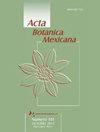Bioactive compounds, antioxidant and antibacterial properties of the pulp, peel and aril of the fruit of Clusia quadrangula (Clusiaceae)
IF 0.8
4区 生物学
Q4 PLANT SCIENCES
引用次数: 0
Abstract
Background and Aims: The Clusiaceae family is known for its bioactive compounds with beneficial antioxidant and anti-inflammatory properties. The objectives of this study were to 1) identify and quantify the individual polyphenol compounds in the methanolic extract from peel, pulp and aril of the fruit of Clusia quadrangula by UPLC-MSMS, evaluate their antioxidant properties, 2) analyze the fatty acid profile, minerals composition and 3) determine the antibacterial activity against pathogenic bacteria of the methanolic extract.Methods: Physicochemical properties, antioxidants and bioactive compounds, fatty acid profile and mineral content were analyzed using a Microplate Spectrophotometer, Ultra High Performance Liquid Chromatography coupled with a triple quadrupole Mass Spectrometer, Gas Chromatography coupled with a Mass Spectrometer and Microwave Plasma Atomic Emission Spectroscopy.Key results: Twenty phenolic compounds were identified and quantified plus the precursor shikimic acid (103.55 µg/g solids). Procyanidin B2 (41.56 µg/g solids), (−)-epicatechin (34.07 µg/g solids), and ellagic acid (27.58 µg/g solids) were found in greater quantity in the methanolic extract of the pulp. Palmitic and linoleic acid were the most abundant fatty acids in the pulp, peel, and aril, and linolenic acid was present in the pulp. The pulp also exhibited the highest amount of total polyphenolic compounds (24.33 mg GAE/g) and reducing power evaluated by FRAP (18.697 mg ET/g). Analysis of the minerals revealed that all fractions are rich in magnesium, potassium, sodium, and calcium. The results showed that the methanolic extract of the different parts of the fruit had antibacterial properties against Salmonella typhi, Escherichia coli, Staphylococcus aureus, and Enterococcus faecalis. Conclusions: These results indicate that different parts of the C. quadrangula fruit are a rich source of natural antioxidants and possess antibacterial properties. Therefore, it can be considered for use as ingredient or additive in the cosmetic, pharmaceutical, or food industries.四角藤果肉、果皮和假种皮的生物活性成分及抗氧化、抗菌特性
背景与目的:月桂科植物以其具有抗氧化和抗炎作用的生物活性化合物而闻名。本研究的目的是:1)利用超高效液相色谱-质谱联用技术(UPLC-MSMS)对四角木果皮、果肉和假皮甲醇提取物中的多酚类化合物进行鉴定和定量,并评价其抗氧化性能;2)分析其脂肪酸谱和矿物质组成;3)测定其对致病菌的抗菌活性。方法:采用微孔板分光光度计、超高效液相色谱联用三重四极杆质谱仪、气相色谱联用质谱仪和微波等离子体原子发射光谱分析其理化性质、抗氧化剂和生物活性成分、脂肪酸谱和矿物质含量。主要结果:鉴定并定量了20种酚类化合物和前体莽草酸(103.55µg/g固体)。原花青素B2(41.56µg/g固体)、(−)-表儿茶素(34.07µg/g固体)和鞣花酸(27.58µg/g固体)在果肉的甲醇提取物中含量较高。棕榈酸和亚油酸是果肉、果皮和假种皮中含量最多的脂肪酸,亚麻酸是果肉中含量最多的脂肪酸。果肉中总多酚化合物含量最高(24.33 mg ET/g), FRAP评价的还原力最高(18.697 mg ET/g)。对矿物的分析表明,所有馏分都富含镁、钾、钠和钙。结果表明,果实不同部位的甲醇提取物对伤寒沙门氏菌、大肠杆菌、金黄色葡萄球菌和粪肠球菌均有一定的抑菌作用。结论:四角果不同部位含有丰富的天然抗氧化剂,具有抗菌作用。因此,它可以被认为是化妆品、制药或食品工业的成分或添加剂。
本文章由计算机程序翻译,如有差异,请以英文原文为准。
求助全文
约1分钟内获得全文
求助全文
来源期刊

Acta Botanica Mexicana
生物-植物科学
CiteScore
1.60
自引率
12.50%
发文量
52
审稿时长
>12 weeks
期刊介绍:
Acta Botanica Mexicana da a conocer trabajos originales e inéditos en todas las áreas de la botánica, incluyendo florística, taxonomía, taxones nuevos para la ciencia, ecología, etnobotánica, paleontología, evolución, conservación, etc. Está dirigida a botánicos mexicanos y extranjeros que aporten información en estas áreas del conocimiento, particularmente con plantas nativas del continente americano. Hasta 2018 apareció cuatro veces al año con una periodicidad estricta en la primera semana de enero, abril, julio y octubre; a partir de 2019 se publica de manera continua, sin periodicidad preestablecida, en formato electrónico y de forma gratuita.
 求助内容:
求助内容: 应助结果提醒方式:
应助结果提醒方式:


